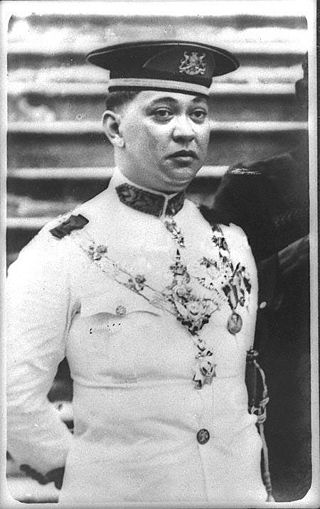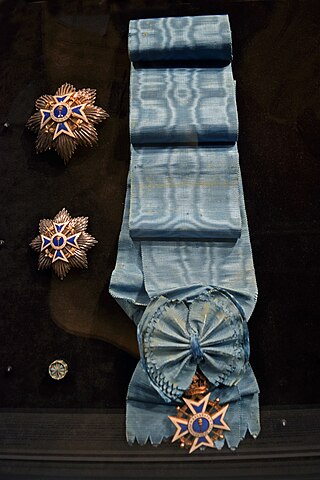
Fuad I was the Sultan and later King of Egypt and the Sudan. The ninth ruler of Egypt and Sudan from the Muhammad Ali dynasty, he became Sultan in 1917, succeeding his elder brother Hussein Kamel. He replaced the title of Sultan with King when the United Kingdom unilaterally declared Egyptian independence in 1922.

Khedive was an honorific title of Persian origin used for the sultans and grand viziers of the Ottoman Empire, but most famously for the viceroy of Egypt from 1805 to 1914.

Sultan Ismail Al Khalidi Ibni Al-Marhum Sultan Sir Ibrahim Al-Masyhur was the 23rd Sultan of Johor and the 3rd Sultan of Modern Johor.

Isma'il Pasha was the Khedive of Egypt and conqueror of Sudan from 1863 to 1879, when he was removed at the behest of Great Britain and France. Sharing the ambitious outlook of his grandfather, Muhammad Ali Pasha, he greatly modernized Egypt and Sudan during his reign, investing heavily in industrial and economic development, urbanization, and the expansion of the country's boundaries in Africa.

Anglo-Egyptian Sudan was a condominium of the United Kingdom and Egypt in the Sudans region of northern Africa between 1899 and 1956, corresponding mostly to the territory of present-day South Sudan and the Sudan. Legally, sovereignty and administration were shared between both Egypt and the United Kingdom, but in practice the structure of the condominium ensured effective British control over Sudan, with Egypt having limited, local power influence in reality. In the meantime, Egypt itself fell under increasing British influence. Following the Egyptian Revolution of 1952, Egypt pushed for an end to the condominium, and the independence of Sudan. By agreement between Egypt and the United Kingdom in 1953, Sudan was granted independence as the Republic of the Sudan on 1 January 1956. In 2011, the south of Sudan itself became independent as the Republic of South Sudan.

Sultan of Egypt was the status held by the rulers of Egypt after the establishment of the Ayyubid dynasty of Saladin in 1174 until the Ottoman conquest of Egypt in 1517. Though the extent of the Egyptian Sultanate ebbed and flowed, it generally included Sham and Hejaz, with the consequence that the Ayyubid and later Mamluk sultans were also regarded as the Sultans of Syria. From 1914, the title was once again used by the heads of the Muhammad Ali dynasty of Egypt and Sudan, later being replaced by the title of King of Egypt and Sudan in 1922.

Sultan Hussein Kamel was the Sultan of Egypt from 19 December 1914 to 9 October 1917, during the British protectorate over Egypt. He was the first person to hold the title of Sultan of Egypt since the killing of Sultan Tuman II by the Ottomans in 1517 following their conquest of Egypt.

The Royal Order of Kalākaua I was instituted on 28 September 1874 by King Kalākaua I to commemorate his accession to the throne of the Kingdom of Hawaiʻi on 12 February 1874.

The Order of the Nile was established in 1915 and was one of the Kingdom of Egypt's principal orders until the monarchy was abolished in 1953. It was then reconstituted as the Republic of Egypt's highest state honor.

The Most Esteemed Order of the Defender of the Realm is a Malaysian federal award presented for meritorious service to the country. The Order Motto are 'Dipeliharakan Allah-Pangkuan Negara'.
The Order of the Brilliant Star of Zanzibar is a decoration awarded by the Sultan of Zanzibar for meritorious services and since The Order of Independence was created in 1963 it is reserved for the persons rendering extraordinary service to the Sultan, his heirs and successors and other members of the Royal family. It was state order from its inception in 1865 to the overthrow of the Sultanate on 12 January 1964 and currently is a House Order of the Zanzibari Royal Family. Current Grand Master is Sayyid Jamshid bin Abdullah Al Said, Titular Sultan of Zanzibar. Initially the decoration had two grades, the first of which was usually awarded to foreign heads of state and the second which was further subdivided into five hierarchical classes. Currently the second grade only is being awarded.

Hussein Refki Pasha Ahmed Hafez Mohammed Hafez was an Egyptian military general and politician who served as Egypt's 25th Minister of War and Marine.

The Order of the Star of Jordan or The Order of Hussein ibn Ali is an award and military decoration of the sovereign state of Jordan and is awarded for military or civil merit. It was founded in honour of his father, by King Abdullah I on 22 June 1949. The Grand Cordon class was introduced by Hussein of Jordan on 23 September 1967. It is awarded to members of the Royal Family (Hashemite) in two classes. The award possesses 5 Grades; plus a medal. These may be awarded to anyone deserving. A Ribbon is issued for members of the military; Dark green with narrow purple edge stripes. Recipients use the postnomials SJ which are altered depending on the class awarded; GCSJ for Grand Cordon; GOSJ for Grand officer; CSJ for Commander; OSJ for Officer; and KSJ for Knight.
The following is the orders, decorations, and medals given by Governor / Yang di-Pertua Negeri of Sarawak. When applicable, post-nominal letters and non-hereditary titles are indicated. The presentation of the award was usually held at The Astana, the Governor's official residence.

The Order of the Throne is a state decoration of the Kingdom of Morocco awarded for distinguished services of a civil or military nature. The Order was instituted on 16 May 1963 by King Hassan II of Morocco, who reigned between 1961 and 1999.
The following is the orders, decorations, and medals given by Sultan of Terengganu. When applicable, post-nominal letters and non-hereditary titles are indicated.
The following is the orders, decorations, and medals given by Sultan of Kelantan. When applicable, post-nominal letters and non-hereditary titles are indicated.

The Order of Besa was established by Ahmet Zogu when he was President of Albania. Founded on 22 December 1926, it was initially awarded in four classes and a medal. It was limited to six ordinary recipients of Albanian nationality, and not awardable to foreigners.
Mahmoud Fakhry Pasha (1884–1955) was an Egyptian politician and diplomat. He held several cabinet and high-ranking diplomacy posts. He was related to the royal family of Egypt who married first the daughter of Sultan Hussein Kamil and then the daughter of King Fuad.














